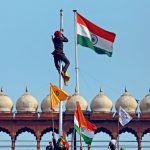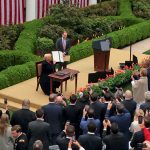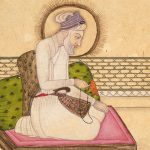Modi and the Other Idea of India
The mistake of conflating Hindutva 2.0 with the Sangh ideology
 Sumantra Bose
Sumantra Bose
 Sumantra Bose
|
21 Jun, 2019
Sumantra Bose
|
21 Jun, 2019
/wp-content/uploads/2019/06/ModiIndia1.jpg)
“ALL NATIONALISM,” THE British Marxist Tom Nairn wrote in 1975, “is both healthy and morbid. Both progress and regress are inscribed in its genetic code… That is a structural fact.”
Narendra Modi is an Indian nationalist. He belongs to a school of Indian nationalism that existed on the fringes of the nation’s politics until 30 years ago. The dominant, state-affiliated school of Indian nationalism post-1947 regarded, and derided, this fringe competitor as a deviant tendency and a political perversion. The pejorative term ‘communalism’ was used to describe the ideology rooted in the Hindutva concept. A completely misleading term, (Hindu) ‘fundamentalism’, was often used in the 1990s, and even later, to describe the movement that rocketed from the margins to the centre stage of Indian politics on the momentum of the early 1990s Ramjanmabhoomi campaign.
In fact, I argued in academic writings from 1990s onwards, the dismissive label ‘communalism’ would no longer suffice. Even less the faulty ‘fundamentalism’ tag—a mis-characterisation caused by the movement’s strategic use of religious symbols and rhetoric. The rising Hindu nationalist movement, I claimed, represents an alternative, thoroughly modern formulation of Indian nationalism with a lineage dating to the 1920s and 1930s, when its ideological fundamentals were elaborated, first by Vinayak Damodar Savarkar and then by Madhav Sadashiv Golwalkar. A century later, Modi is that movement’s poster child.
There are still people who regard the Hindutva-based definition of Indian nationalism as intrinsically illegitimate, at variance with the ‘idea of India’. This nonsense of a singular ‘idea of India’ has been peddled for the past two decades. It is utterly ahistorical. Since the early 20th century, India and its identity as a nation have been defined in multiple ways by Indians. The definition elaborated by Savarkar and Golwalkar is no less an ‘idea of India’ than any other. Those who hold their idea of India in contempt no longer sneer at it. The disdain has given way to fear, foreboding and despair.
Modi has spent his entire adult life—five decades—in the folds of a movement with a very clear ideology of what constitutes the basis and essence of the Indian nation, and a very definite vision of what the Indian state should be. He is not Donald Trump, a property developer-turned-political buccaneer. Nor is he a single-issue maverick like Nigel Farage, the foppish country squire lookalike who personifies English Europhobia and is at the moment England’s most popular politician.
Perhaps the closest comparable figure to Modi is Turkey’s Recep Tayyip Erdoğan. Both are of working-class origins. Both have commanding presidential-style personalities— after being prime minister for 11 years, Erdoğan was elected president in 2014 and three years later won a referendum to concentrate almost all power in the presidency, making a rubber-stamp of the Turkish parliament. Both utterly dominate their respective political parties. Modi is now developing a record similar to Erdoğan’s—who has consecutively won six parliamentary and two presidential elections—of turning national elections into plebiscites on his leadership and winning them after outwitting opposition coalitions devised solely to defeat him. Their campaign styles blend charisma with well-honed party machines, and exude confidence and resolve. In 2017, Erdoğan galvanised his party for coming elections in language similar to both Modi’s and Amit Shah’s: “We have to work hard to win the hearts of people. Do not leave any door without a knock or any hand unshaken. We have to win 50 per cent plus one per cent of the votes.”
In office, Modi and Erdoğan have used identical slogans for their governance agendas (‘New India’ and ‘New Turkey’) and share the habit of fixing historic anniversaries as project deadlines. In India, it’s been 150 years of Gandhi’s birth (2019) and the 75th anniversary of independence in 2022, while Erdoğan has declared 2023, the centenary year of the Turkish Republic, as the deadline for various grandiose schemes.
The most fundamental commonality is that both Modi and Turkey’s Erdoğan represent ideological movements for restoring to their 21st century nations and identity these movements believe to be their true character
The most fundamental commonality is that both Modi and Erdoğanrepresent ideological movements for restoring to their 21st century nations the identity these movements believe to be their true character. Turkey nominally remains a secular state as laid down by its founders, but after 16 continuous years of Erdoğan in power, the republic founded by Mustafa Kemal (Atatürk) is effectively based on the Hanafi-Sunni Islamist ideology of Erdoğan’s Justice and Development Party (AKP), which is also the confessional identity of the majority of Turkey’s population. Like the Bharatiya Janata Party (BJP) and its predecessor, the Bharatiya Jana Sangh (BJS), the AKP’s (formed 2001) several predecessor parties representing the Turkish Sunni-Islamist movement were a minor political force until the 1990s. And like the movement built around the Rashtriya Swayamsevak Sangh (RSS) core, those who held Turkish national identity to be based above all on the millennium-old faith of the Sunni majority of Anatolia were stigmatised and ridiculed until a decade ago by the Europhile Kemalist elite. Erdoğan turned the abuse on its head by proudly proclaiming his ‘Black Turk’ (humble, subaltern) roots, in contrast to the privileged ‘White Turk’ loyalists of the decrepit Kemalist order. That resonated with his mass following, just as the self-descriptions of ‘chaiwaala’ and ‘kaamdaar’, not ‘naamdaar’ worked for Modi in 2014 and 2019.
Under Erdoğan, the alternative definition of the Turkish nation was not just mainstreamed—it achieved political dominance. His future is somewhat uncertain, because Turkey’s economy, always structurally weak, is on the brink of collapse. But even in such dire economic circumstances, in most countries a sure condition for rejection of the incumbent, his party lost control of Istanbul in local elections this spring by just a whisker. Erdoğan was unable to stomach this—his ascent to the pinnacle began with his election as Istanbul’s mayor in 1994, and Istanbul has a fifth of Turkey’s population. So he has engineered a rerun of the Istanbul election on June 23rd, 2019. Whatever the outcome, and its aftermath, there will be no return to the Kemalist Turkey of yore. The ideological transformation of the Turkish state that Erdoğan has led over the past two decades will largely endure.
The regimes of Modi and Erdoğan are Janus-faced. Janus, the ancient Roman god, literally had two faces. The deity appears in sculptures and on coins with two faces—one looking left, the other right—mounted on one neck and sharing the same head. The compositeness in duality defined Janus, and his place in Roman dharma. He simultaneously represented past and future, entrances and exits, beginnings and endings, war and peace. Above all, he symbolised change and transition. Both his faces were equally important, true and real, neither being a mask nor a masquerade for the other. Nairn’s essay on the nature of modern nationalism—at once progressive and regressive, healthy and morbid—is titled ‘The Modern Janus’.
One face of the Janus-like Modi and Erdoğan regimes is expressive of the aspiration to socio-economic development and progress that runs through their countries. Erdoğan entrenched his dominance due to AKP victories in three successive parliamentary elections in 2002, 2007 and 2011— each time with larger vote shares and parliamentary majorities. This success was above all because Turkey’s economy enjoyed a remarkable recovery during that time from a total collapse in 2001, an event which delivered the last nail in the ready-to-go coffin of the Kemalist political class. Coupled with healthy economic growth, millions of pious Sunni Muslim Turks in metropolitan slums, provincial towns and rural areas were thrilled to see one of their own emerge as the country’s leader.
There are still people who regard the Hindutva-based definition of Indian nationalism as intrinsically illegitimate, at variance with the ‘Idea of India’. This nonsense of a singular ‘Idea of India’ has been peddled for the past two decades
Likewise, Modi’s brilliant connect with ‘aspirational India’ worked wonders in 2014, helped along by the discredited status of the UPA-II Government. In my recent book Secular States, Religious Politics: India, Turkey, and the Future of Secularism (Cambridge University Press, 2018), I call the 2014-2019 BJP Government ‘Hindutva 2.0’, representing both continuity with and evolution from the Vajpayee-helmed coalition Governments led by the BJP at the turn of the century. The face of Hindutva 2.0 that proved decisive in 2014 was the developmental face, with Modi as the dream merchant of jobs and a shining economic future (‘sapno ka saudaagar’, borrowing the title of a late 1960s Bollywood movie): ‘sab ka saath, sab ka vikaas,’ poverty elimination not poverty alleviation. Since 2014, Modi has systematically inscribed that face of Hindutva 2.0 with his personal brand—he alone can be the development messiah, if there is to be one. He has ‘underwhelmed’ in substantive terms, but more Indians than not decided to give him a second chance in 2019—due to the absence of any credible alternative (on which more below).
The other face of Janus is equally pertinent. Erdoğan’s Turkey is one of the world’s most repressive states. It is a republic of fear. The promise of democratic deliverance from eight decades of draconian Kemalism has turned into a nightmare. The slide into blatant authoritarianism accelerated from 2013, after Erdoğan succeeded in bringing to heel the military, whose secularist hierarchy had been the ultimate arbiters of Turkish politics since Turkey’s first of several coups in 1960. Since a failed military coup in July 2016 orchestrated by a rogue Islamist faction that had been an Erdoğan/AKP ally until 2013, tens of thousands have been thrown into prison, and hundreds of thousands have lost their jobs and livelihood by the regime’s fiat. Many, probably most, of these people had nothing to do with the 2016 coup attempt. Meanwhile, buttressed by narrow victories in elections and referendums against an ineffective opposition, the Erdoğan personality cult steamed on to its goal of total control of state power.
India is not Turkey. It is a much larger and socioculturally much more diverse country. India has been a functioning democracy for seven decades, whereas Turkey never developed a stable democratic regime following the end of a quarter-century of Kemalist one-party rule in 1950—until Erdoğan’s rise, which degenerated after a decade into a neo-sultanistic autocracy. India has a myriad of constitutional checks and balances to check concentration of power amounting to dictatorship. That has not always worked: recall the Emergency. But it largely has. And in contrast to the rigidly monolithic, homogenising nation-state model of the Turkish republic since its inception in the 1920s, the Indian republic established in 1950 endorsed and practiced multiculturalism, multilingualism and a relatively decentralised structure of state power.
Yet there are some disquieting parallels between Modi’s India and Erdoğan’s Turkey. Turkey’s Alevis, an especially heterodox branch of Middle Eastern Shi’ism estimated to be 15-20 per cent of Turkey’s population, are the country’s main confessional minority. They are regarded as heretics by many among the pious Sunni Turks who support Erdoğanand his party. In the Erdoğan era, Alevis have been almost completely squeezed out of the state and its institutions, and effectively reduced to second- class citizenship. They were not especially well-off under the ‘secular’ Kemalist dispensation, but their marginalisation and degradation in Erdoğan’s Sunni- Islamist state of the 21st century is significantly worse. Their situation is analogous to the prospects that stare in the face of India’s Muslims today.
There are other parallels. In June 2015, Erdoğan’s party narrowly failed to win an outright majority in Turkey’s parliament, for the first time since the AKP’s historic breakthrough in November 2002. Erdoğan decided to correct this by reverting to a Kemalist-style hardline on Turkey’s burning Kurdish question. The bizarre Kemalist republic had denied the very existence of Kurds as a distinct community within the state since the mid-1920s. This policy of forced assimilation of Kurds into a monolithic Turkish identity eventually led to a Kurdish insurgency in Kurdish-majority areas of eastern and southeastern Turkey that raged from the mid-1980s until 1999. After the insurgency was subdued, civil unrest continued in those areas. Following the relative setback in the June 2015 parliamentary election, Erdoğanopted for a mailed-fist approach against restive Kurds in eastern and southeastern Turkey in order to consolidate Turkish nationalist opinion behind his party. It worked. In a snap general election in November 2015, the AKP regained its single-party majority, and that paved the way for Erdoğan to subsequently consolidate his absolute power. The renewed repression of Kurds unleashed by Erdoğan’s regime since 2015 copied the old Kemalist state-terrorism. The festering Kurdish issue serves broadly the same purpose in Erdoğan’s electoral strategy as Kashmir did in the winning Modi/Shah game plan of 2019.
The rising Hindu nationalism represents a modern formulation of Indian nationalism with a lineage dating to the 1920s and 1930s, first by Savarkar and then by Golwalkar. A century later, Modi is that movement’s poster-child
WHAT DEFINES THE ideological face of the Hindu nationalist Janus?
The political doctrine of Hindutva has three core beliefs. The first is the innate unity of Hindus. The purpose of the movement’s politics is to instil this consciousness of Hindu unity, and eliminate or neutralise the sources of disunity, in order to turn the innate characteristic into a powerful, living reality.
Second, India is a Hindu land, not a ‘composite’ melange of communities nor a melting pot of various influences down the ages. This is evident in Savarkar’s pitrubhoomi-punyabhoomi construct. Golwalkar was categorical from the late 1930s that the word ‘Hindusthan’ stood for “the land of the Hindus”, and like Savarkar, he insisted that the nature of the sovereign Indian state must be based on this truth.
Third, Muslims living in India—until 1947, of the subcontinent as a whole—are an irreconcilable enemy of Hindudom and undeserving of the status of fellow-citizens. The problem, Savarkar said in his presidential speech to the Hindu Mahasabha’s annual convention in Nagpur in 1938, was that “the Moslems remained Moslems first, Moslems last and Indians never” and declared that “the fact is that the whole Moslem community is communal, including the Congressite Muslims”. Golwalkar warned in the late 1960s of the lurking presence of “the Muslim menace… wherever there is a masjid or a mohalla” and bemoaned the existence of “countless miniature Pakistans” in Hindusthan. This grave threat, he asserted, made Hindu unity an urgent imperative. Anirudh Mathur, a former graduate student of mine at the London School of Economics and Political Science, rightly noted in a 2015 paper that ‘Hindutva cannot move beyond’ this stance on India’s Muslims because it has been ‘an unchallengeable and axiomatic part of the theory’ of Hindutva since its inception. So, ‘polarising’ electoral strategies are not simply an expedient, but stem from a core belief of Hindutva’s ideological system.
Asking a Hindu nationalist to accept India’s Muslims as brethren and equals would be like asking an indoctrinated Marxist to give up the notion of the class enemy. What can be expected, at most, is what Modi told a BJP national council meeting in 2016, quoting Deendayal Upadhyaya: “Musalman ko na puraskrit karein, na tiraskrit karein, unka parishkaar kare” (neither reward nor rebuke Muslims, purify them). Asking a Hindu nationalist to rethink the first and second cardinal principles of his world view would be like asking his Marxist counterpart to question the inexorable unity of the world’s workers and the concept of the dictatorship of the proletariat.
It can be reasonably inferred that Narendra Modi’s ‘idea of India’ revolves around these three core beliefs, given his lifetime of service in a movement where he has risen from unknown foot-soldier to feted supreme leader. In 2008, Modi published a Gujarati book about 16 men who have inspired him, directly or indirectly. All 16 belonged to the RSS, and the single longest sketch is that of ‘Shri Guruji’, MS Golwalkar.
Can Modi accept that the version of Indian nationalism his ideological movement represent is only one of several idea of India? Savarkar and Golwalkar were characterising as nationalist imposters all but those who subscribed to their own idea of India, and that included Gandhi, Bose and Patel
Unlike India’s first Hindu nationalist Prime Minister Atal Bihari Vajpayee, Modi cannot be accused of being a mukhauta (mask) for an underlying agenda. He represents both faces of the contemporary Hindutva Janus, but has been able to foreground the vikaas purushface to great effect because he has had the perfect alter ego since 2014—in Amit Shah, as BJP president—to represent the ideological face, along with senior RSS ideologues and assorted loose-cannon personalities of the Sangh Parivar. This division of labour has enabled Modi to just about maintain his lofty prime-ministerial pedestal without getting personally tainted by the ‘nasty party’ label that dogs Britain’s Conservative and Unionist Party (the English Tories). Modi’s tactic during his first term of observing strategic silence for as much and as long as possible on the most brutish manifestations of Hindutva activism, such as the cow-vigilante lynch gangs, speaks well of his political shrewdness.
In my book, I call the contemporary version of Hindutva— that of the Modi (plus Shah) era—Hindutva 2.0 because it represents a revised and updated edition of the classic canon, adapted to the context of early 21st century India. In three key areas, Hindutva 2.0 diverges from the traditional positions of the Hindu nationalist movement and its political party (BJS and then BJP), but without deviating from the framework of the three cardinal principles. There have of course been other changes, such as the shift from a tradition of collective authority in the BJS and BJP—where Vajpayee even as Prime Minister was first among equals—to a leader-centred model under the Modi-Shah duopoly. But I am more concerned in this essay with the Hindutva ideology. My former student Anirudh Mathur’s insights helped me appreciate where the current edition of Hindu nationalism has revised the pristine ideology to keep up with the evolution of India and the world, whilst staying faithful to the fundamentals laid down by the prophets.
Hindutva 2.0 has junked the traditional Sangh preoccupation with Swadeshi—economic self-reliance amounting to autarky, and specifically advocacy for small traders and shopkeepers—in favour of a full-blooded embrace of global capitalism
First, Hindutva 2.0 has decisively junked the traditional Sangh preoccupation with swadeshi—economic self-reliance amounting to autarky, and specifically advocacy for small traders and shopkeepers—in favour of a full-blooded embrace of global capitalism. The slogan ‘Make in India’ best symbolises this. The shift has several underlying and proximate causes: India post-1991 (the liberalisation of the economy); the world post-1991 (the Soviet Union ceased to exist); the rise of ‘communist’ China as a hyper-capitalist state and the ‘world’s factory’; and the dire need to generate manufacturing jobs in today’s India for the bulging youth population. The animal spirit of turbo-charged capitalism also fits well with the Modi/Shah narrative of turbo-charged nationalism. Making Bharat great again in early 21st century conditions necessitates this shift. In the process, lobbies such as the Swadeshi Jagran Manch, which wielded some influence during the Vajpayee premiership, have been relegated to obscurity under Hindutva 2.0.
Second, Hindutva 2.0 has moved beyond the traditional Hindu nationalist reticence and ambiguity on matters of caste. That awkwardness was quite natural: for a movement whose premise is the organic oneness of the Hindu subspecies of humanity, the inequities and oppressions of caste are a most difficult subject to deal with. The domination down the decades of the RSS leadership by Brahmins, mostly Maharashtrian Brahmins, did not help. The RSS chief Mohan Bhagwat’s outburst on the issue of reservations on the eve of the November 2015 state election in Bihar, which the BJP lost, simply reflected the well-known dislike of generations of RSS leaders for caste-based reservations (Bhagwat’s own father was a prominent figure in the early RSS). Golwalkar wrote in the late 1960s that although ‘the caste system has degenerated beyond all recognition’, it had ‘in fact served as a great bond of social cohesion for thousands of years of our glorious National Life’.
After so many decades of prevarication and evasion, Modi and Shah have concretely put into effect, in electoral politics at least, what Savarkar urged on a lukewarm audience in his presidential speech to the Hindu Mahasabha’s annual convention in Calcutta in 1939. He urged the delegates to reject untouchability and told them that “this will enable you to consolidate your own brethren who are religiously, culturally and nationally as much a part and parcel of Hindudom as any of us [present here] can claim to be”.
Erdoğan believes his Hanafi-Sunni Islamist concept to be the only legitimate and culturally authentic formulation of Turkish nationalism. Around half of Turkey;s population disagree: A mix of ideological secularists, Alevis, Kurds and even, by now, many sidelined senior figures of Erdoğan’s own party
Since the 2014 victory—which, as Modi admitted during the 2019 campaign, was more an “anti-incumbency” vote than anything else—he and Shah worked strategically to retain, and expand, the BJP’s support among Hindus of middle and low castes who had generally been outside the party’s net. They have succeeded to a significant extent. The strategy combined Modi’s frequent obeisance to BR Ambedkar, and flattering references to Ram Manohar Lohia, with clever exploitation of simmering resentment and a sense of relative deprivation among non-Yadav OBCs and non-Jatav Dalits. The coup de grace was provided by the bouquet of Central welfare and uplift schemes, all carefully branded with Modi’s personal imprimatur, which disproportionately benefit poor, lower- caste Hindus. The shallow electoral alliance of the Samajwadi Party (SP) and Bahujan Samaj Party (BSP) was rendered ineffectual in Uttar Pradesh, and in Bihar—thanks also to the chameleon Nitish Kumar’s collaboration—the jailbird Lalu Prasad’s party sank without a trace. In a brilliant balancing act, Modi and Shah concurrently managed to keep upper castes on side across northern India. But their success in attracting non- elite Hindus was not limited to Hindi-speaking India. In West Bengal, my own state, the BJP won the single largest share of Scheduled Caste (SC) votes and a decisive majority of the smaller Scheduled Tribe (ST) electorate. That was mostly because of local, state-level dynamics beyond the scope of this essay, but does reveal the success of Hindutva 2.0 in transcending the geographic and social barriers that limited the BJP’s growth during the 1990s and 2000s.
The significance of this success extends beyond electoral gains. It represents a step towards realising the pristine but elusive ideal of pan-Hindu unity, surmounting caste divisions and towards the making of an eventual Hindu Rashtra, a republic that embodies the collective spirit of a unified Hindudom. And it adds to the marginalisation of the Muslim enemy. The fact that one of every five UP voters is Muslim was rendered redundant first in 2014, then in the state election of 2017 and now—and most emphatically—in 2019, with the BJP actually achieving the 50 per cent vote share that most had dismissed as Amit Shah’s bombast. In West Bengal, where Muslims are at least 27 per cent of the electorate and voted nearly en masse for Mamata Banerjee’s party, the BJP, despite a weak state organisation and leadership, won over 40 per cent of the popular vote and almost half the state’s Lok Sabha seats.
The third aspect in which Hindutva 2.0 has diverged from Hindu nationalist dogma is perhaps the most intriguing and potentially the most significant for the near-term future of India’s politics. Just 50 years ago, Guru Golwalkar called for “the [1950] Constitution [to] be re-drafted” to “sweep away all autonomous and semi-autonomous states within Bharat”, “bury for good all talk of a federal structure”, “establish Unitary form of Government” and “proclaim ‘One Country, One State, One Legislature, One Executive!’” Golwalkar believed that the moderately decentralised structure of India that took shape through the 1950s and 1960s was an incitement to “fragmentational [sic], regional, sectarian, linguistic [and] other types of pride” to “play havoc with our integrated harmony”. The agitation for ‘Ek Nishaan, Ek Vidhaan, Ek Pradhaan’ (One Flag, One Constitution, One Premier) that the new-born Jana Sangh led by Syama Prasad Mookerjee launched in Jammu and Kashmir in the early 1950s in coordination with its local Jammu affiliate, the Praja Parishad, reflected this broader ideological view of what the structure of Bharat should be.
Hindutva 2.0 is a very formidable concoction. It represents a pragmatic revision of aspects of the original political philosophy of Hindutva, but still completely consistent—indeed congruent—with the spirit and ideals of the original
The architects of Hindutva 2.0 know that if one defining feature of the last three decades of Indian politics has been the rise of their political party from the margins to centre stage, the other has been the proliferation of regional parties in many states of the Union. Unlike the Congress, whose withered presence no longer constitutes any threat to Hindutva 2.0’s goal of pan-Indian dominance, the variegated assortment of regional parties is, by and large, still a factor to contend with in their states. This was true in 2014 and still is in 2019, despite the battering most of the influential regional parties have received from the Modi-Shah juggernaut.
In recognition of this evolution of India’s politics since the 1990s, Hindutva 2.0 adopted the mantra of ‘cooperative federalism’ from 2014 onwards. The phrase is most often associated with Arun Jaitley’s tenure as Finance Minister, but Modi has also used it and echoed it in more general terms: “Our diversity is our strength.” There is certainly a precedent for this evolution in Vajpayee’s two coalition Governments (1998- 1999 and 1999-2004), which were propped up by regional parties. But those were arrangements dictated by the mutual needs of the BJP and its regional allies, andVajpayee never invoked federalism explicitly. And unlike Vajpayee, Modi was not dependent on regional parties for the survival of his 2014-2019 Government.
Hindutva 2.0 aspires to pan-Indian political hegemony. In 2017, with Modi at his side, Amit Shah told a meeting of the BJP national executive in Bhubaneswar that his job as party president would not be complete until the BJP dominated India “from panchayat to Parliament” and “every state” of India had a BJP government. Shah was flush from the BJP triumph in the 2017 UP state election and his tone was hyperbolic, but the statement was one of serious intent.
In early 21st century India, where regional parties are (still) the main obstacle standing in the way of Shah’s ambition, linguistic and other communitarian identities are politically salient, and many, perhaps most, Indians feel a strong identification with their states, the route to realising that ambition is not to try and implement what Golwalkar advocated 50 years ago. It lies in winning power in previously unwinnable states, retaining those already won and regaining those temporarily lost. This is a long, hard slog, a war of attrition. But pan-Indian hegemony can only be achieved through control of the maximum number of state capitals. This would also give the BJP its much-needed majority in the Rajya Sabha, which is already within sight by late 2020.
For the states-based strategy to succeed, the BJP simply cannot be seen to be a unitarist, anti-federal party wedded to an overarching ideology of Hindu homogeneity that gives short shrift to other identities and affiliations. It instead needs to be sensitive to the particular contexts of states and respectfully acknowledge linguistic and other communitarian identities, with a view to co-opting and subsuming those identities—as with caste—into the Hindu nationalist framework. This is the path, in contemporary conditions, to realising the vision of the pioneers of the movement. In his victory speech at the BJP office in New Delhi on the evening of May 23rd, 2019, Modi distilled this approach into a new coinage—‘NARA’ (the call), standing for ‘national ambition and regional aspirations’—with the powerful claim that the BJP represents both in equal measure and is the only party capable of doing so. The broadly pro-federal, sensitive-to-states stance has another advantage. If the BJP and its Central Government cannot be plausibly seen as an enemy of state autonomy and regional identities, it becomes easier to shift the focal point of political conflict to within states and stoke Hindu consolidation against Muslim minorities therein. That is precisely what is happening in West Bengal today. Of course, if the BJP were to indeed achieve Shah’s ambition of governing every state of the Union, the Union’s devolved structure would become secondary to the fact of one-party power.
Hindutva 2.0 is a very formidable concoction. It represents a pragmatic revision of aspects of the original political philosophy of Hindutva, but still completely consistent—indeed congruent—with the spirit and ideals of the original. It has brought the Hindu nationalist movement a degree of power— and the possibility of even more—that could only have existed in the fantasies of past generations of its leaders, from Golwalkar and Upadhyaya to Vajpayee and LK Advani.
IN THE FINAL stages of the 2019 campaign, Modi correctly predicted a decisive ‘pro-incumbency’ verdict (and even got the number of seats the BJP would win right—psephology’s or astrology’s loss was clearly politics’ gain). It would be premature, however, to interpret the decisively pro-incumbency outcome as a popular endorsement of the idea of India that Hindu nationalism represents. The outcome resulted from a complex constellation of factors. The weightiest factor was the absence of any remotely credible alternative to five more years of Modi and Shah. The fragmented opposition, flailing about incoherently and essentially hoping against hope for a 2004 redux, was an incumbent’s dream come true. That Modi’s most vocal opponents were caricatures—ranging from hot-air balloons to screeching banshees—amplified his advantage.
In his generally measured victory speech at the BJP headquarters in New Delhi on the evening of May 23rd, Modi betrayed a hint of tongue-smacking triumphalism at only one point. This was when he noted that opposition parties had, in contrast to 2014, failed to challenge him in 2019 on what he called the “nakal” (false, spurious, bogus) grounds of “secularism”— he used the English word in a rare departure in the address delivered in his usual style of semi-formal Hindi.
Savarkar told the Hindu Mahasabha convention in Nagpur in 1938 that “the Hindu nationalists, even if they be called communalists, are the only real Indian Nationalists”. All others claiming to be Indian nationalists, he told the Hindu Mahasabha convention in Calcutta in 1939, were “a pseudo-Nationalistic nuisance”. Around the same time in the late 1930s, Golwalkar wrote in his seminal tract We, or Our Nationhood Defined: ‘Those only are nationalist patriots who, with the aspiration to glorify the Hindu race [sic] and Nation, are prompted into activity and strive to achieve that goal. All others, posing to be patriots and wilfully indulging in a course of action detrimental to the Hindu Nation are traitors and enemies to the National Cause or, to take a more charitable view if unintentionally or unwillingly led into such a course, mere simpletons, misguided ignorant fools.’
Turkey’s Erdoğan believes his Hanafi-Sunni Islamist concept to be the only legitimate and culturally authentic formulation of Turkish nationalism. Around half of Turkey’s population disagree: a mix of ideological secularists, Alevis, Kurds and even, by now, many sidelined senior figures of Erdoğan’s own party. Can India’s Modi be different? Can he accept that the version of Indian nationalism his ideological movement represents is only one of several ideas of India? In the late 1930s, Savarkar and Golwalkar were characterising as nationalist imposters, traitors, enemies and fools all but those who subscribed to their own idea of India. That included the entire spectrum of Indian nationalists struggling and suffering for India’s freedom from colonial slavery, led by such persons as Mohandas Karamchand Gandhi, Subhas Chandra Bose, Jawaharlal Nehru and Vallabhbhai Patel, amongst others. Eighty years on, RSS ideologues claim that only their concept of Indian nationalism is historically rooted and culturally authentic, and all others are Western-inspired and inauthentic. This is nonsense, and perhaps the subject of another essay to come.
Whether Narendra Modi can rise above this false, monopolistic discourse of Indian nationalism will, more than anything else, determine if his Government of the next five years will be more healthy than morbid and more progressive than regressive.
About The Author
MOst Popular
4

/wp-content/uploads/2025/04/Cover-Rashmika-New.jpg)












More Columns
India received a heads up from US on tariffs Rajeev Deshpande
Saving Farmers from the Unions Siddharth Singh
The New Hotspot Kaveree Bamzai